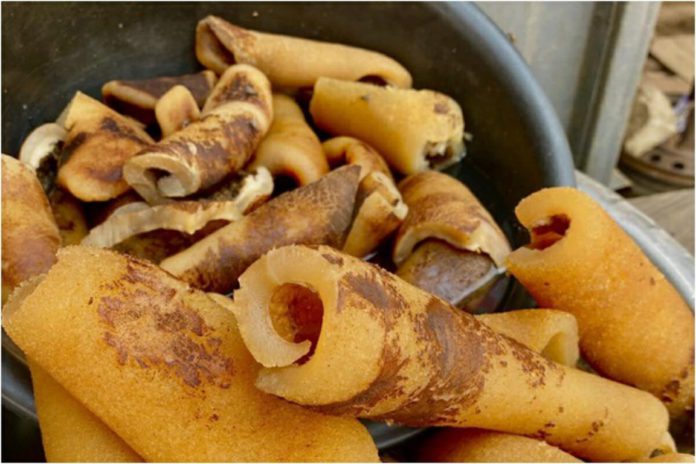The cowhide, commonly known as ‘wele’ that you cannot eat your waakye, Okro stew or any of your favourite meals without, your preference for quality belts, shoes and bags made from leather is dangerous to the environment and climate change.
This is because the practice of burning wele, a common method for disposing of animal remains, poses significant environmental and climate concerns.
While it is seen as a means of waste disposal in some regions, the combustion of animal hides releases a variety of harmful substances into the atmosphere, contributing to air pollution and climate change.
When burned, cowhides emit greenhouse gases such as carbon dioxide (CO2) and methane (CH4), as well as other toxic compounds like sulfur dioxide (SO2) and nitrogen oxides (NOx).
These emissions not only exacerbate global warming but also have negative impacts on human health and local ecosystems.
As the world grapples with the growing urgency to reduce carbon footprints and transition to more sustainable practices, understanding the environmental impact of cowhide burning is crucial.
This article explores the process of burning cowhide, the pollutants it releases, and its broader implications for climate change, highlighting the need for alternative waste management practices in the livestock and leather industries.
Cowhide serves multiple purposes beyond just food, like wele (a delicacy made from boiled cowhide).
The hide is also an important raw material in industrial applications, especially in leather production and various traditional crafts.
The use of cowhide for industrial purposes extends to leather tanneries, the production of drums, furniture, shoes, bags, and other leather goods.
Cowhides in Ghana are usually sourced from local slaughterhouses or cattle markets. After slaughter, the hides are preserved either by drying or salting to prevent decomposition before further processing.
In Ghana, the cowhide processing industry is primarily centered around traditional methods, although some modern practices have been adopted in industrial settings, especially in large tanneries.
The cowhide burning process is still used in certain parts of the country, particularly by small-scale producers, but larger industrial players might opt for chemical dehairing or mechanized processes to improve efficiency.
Traditionally, cowhide is burned using coal and tyres, a process that not only gives wele its distinctive flavour but also lends a slightly smoky taste that many Ghanaians cherish. However, this method is not without its drawbacks.
Burning tyres, in particular, releases harmful pollutants into the air, posing significant health risks to both cooks and consumers.
The practice of burning cowhide using tyres and coal has raised concerns about its environmental impact.
The process releases harmful pollutants such as carbon dioxide (CO₂), sulfur dioxide (SO₂), and particulate matter, all of which contribute to global warming, respiratory issues, and poor air quality.
Additionally, incomplete combustion can produce methane (CH₄) and nitrous oxide (N₂O), both potent greenhouse gases.
The incomplete combustion of tyres and other materials releases fine particulate matter into the air.
These particles can penetrate the lungs and cause serious respiratory issues, such as asthma, bronchitis, and even cardiovascular diseases.
Beyond air pollution, the method also has implications for deforestation. Wood and charcoal, often used as fuel in this process, lead to the loss of forested areas, further contributing to climate change by reducing the Earth’s capacity to absorb CO₂.
Residue from the burning process can also contaminate soil and water sources, posing a threat to local ecosystems.
The ash and residue left behind after burning cowhide, especially when tyres are involved, can contaminate soil.
This contamination reduces soil fertility, affecting agricultural productivity in areas where this practice is common.
In addition, residues and chemicals from burnt tyres can leach into nearby water sources, contaminating rivers, lakes, and groundwater.
This can negatively affect both human populations and local wildlife, as the pollutants are harmful to aquatic ecosystems and can infiltrate drinking water supplies.
The release of large amounts of greenhouse gases during the burning of cowhide, particularly when tyres are used, exacerbates global warming.
This contributes to extreme weather patterns, rising temperatures, and a host of other climate-related issues that impact both local communities and the planet as a whole.
To mitigate the environmental impact of burning cow hides, alternative methods of disposal and waste management must be explored.
One such solution is composting, where cow hides can be broken down into organic matter. This reduces methane and CO2 emissions and can be used as a natural fertilizer in agriculture.
Another option is energy recovery through incineration with controlled combustion. Unlike open burning, incineration in controlled environments can capture some of the harmful emissions and generate energy in the process.
While this still releases CO2, the environmental impact can be significantly reduced through modern filtration technologies.
The leather industry can also explore circular economy practices, such as finding innovative ways to reuse hides or develop bioplastics and other materials from the collagen in animal skins.
By turning waste into value-added products, the industry can reduce the need for burning and its associated environmental harm.
Ultimately, recognizing and addressing the impact of cowhide burning is crucial in our collective journey toward a sustainable future.
It is a reminder that even small-scale practices can have significant environmental repercussions, and by making conscious choices today, we can help pave the way for a healthier planet for generations to come.
Burning cowhide poses significant environmental and climate risks, therefore adopting sustainable alternatives and promoting awareness can mitigate these impacts.

